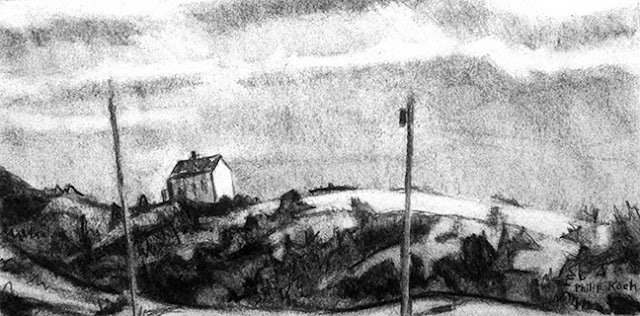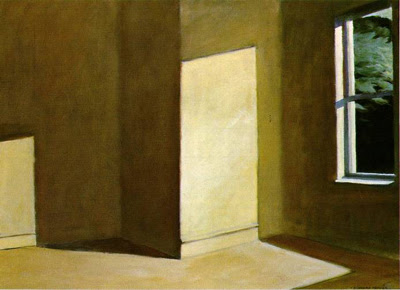Andrew Wyeth
The Brandywine Museum show, Andrew Wyeth in Retrospect, marks the 100th anniversary of Wyeth's birth. Audrey Lewis of the Brandywine Museum co-curated the exhibition, borrowing important Wyeth works from across the country.
I was awed by what I saw. Wyeth has a quiet but insistent power to his imagination. He used "traditional" country and farm imagery but always found ways to show us the unexpected.

For many viewers Wyeth's ability to render painstakingly detailed surfaces is the big takeaway. And impressive it is. For me though, as a realist painter who eschews minute details, what really struck me throughout the show was Wyeth's masterful sense of design- the way he realized expressive power by leaving things out.
The early watercolor Coming Storm (above) from 1938, done before the artist adopted his more detailed way of working in the medium of tempera paint, shows how much he could express using only the most broad and detail-free strokes. ( I apologize for the reflections on some of my photos).
Here's Hoffman's Slough, a tempera from 1947, a masterpiece of leaving things out if there ever was one. In this and other paintings Wyeth plays off areas of relative emptiness against a few carefully chosen focal points that lead our eye around the space of the painting.
A few years ago we took advantage of the tours the Brandywine Museum runs to Andrew Wyeth's studio and to that of his father, N. C. Wyeth, just up the hill. One of my favorite paintings in the show was this watercolor Andrew Wyeth made of his father's studio in the snow, North Light, done late in his career in 1984. The painting starts out telling us all about the delicate lattice work in the upper panes of arched window, but as soon as Wyeth felt he'd said enough the rest of the window gradually dissolves into a mist of blown snow. It's so well done it's mesmerizing.
In a watercolor from 1959, Willard, we see Wyeth feeling his way as he gradually carved out the space in back of his model with the lightest touches of wash. I love the tiny spot of empty white paper he left untouched in the top half of the painting.
Almost at the end of the show is Crow Tree from just two years before the artist's death, a painting that especially grabbed me. With my own paintings of the forest, I've so often been drawn to the solemn elegance of trees that have died. They can stand for years shorn of their leaves, fully revealing the rhythms of their almost sculpted branches. What a pleasure to see Wyeth turning his eye to a similar theme.
A few miles from the Brandywine Museum the Somerville Manning Gallery has mounted a large and wonderful companion exhibition of Andrew Wyeth watercolors. Highly recommended! The Somerville Manning show has been extended to run through September 9. Here's a photo of the Gallery.
Somerville Manning Gallery, a few miles downstream on the
Brandywine River from the Brandywine River Museum.








